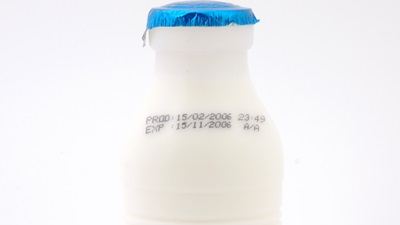
What is your goal when purchasing your food at the grocery store? You may follow these simple rules:
1. Buy lots of fruits and vegetables.
2. Simply, bring your food home, and eat it.
For nine out of 10 Americans, food goes directly from their shopping cart to the kitchen and then into the garbage, according to a survey by the Food Marketing Institute.
This is in direct correlation to the food expiration dates on your food product labels, the labels that say “sell by,” best by,” “use by,” and “best before.” Is there a chance that you’re tossing out perfectly good food because these dates are misleading you?
That’s what a new report, published by Harvard University’s Food Law and Policy Clinic and the Natural Resources Defense Council (NRDC) titled The Dating Game: How Confusing Food Date Labels Lead to Food Waste in America, claims. The report details the confusion surrounding expiration dates and what they mean. They noted that date labels contribute to the waste of edible food, as an estimated 40% of food in the U.S. goes uneaten, totaling 160 pounds (or $165.0 billion in losses) each year.
This far exceeds the food waste of the rest of the world, whereas in Canada it is estimated that about $27.0 billion is lost in food waste each year.
What You Should Know About Food Labels
Awareness is a main factor contributing to food waste. People just don’t know what the labels mean, in part because state and federal regulations and guidelines for expiration date labels are unclear. It is also estimated that 80% of food packaging dates are approximate rather than exact, pertaining to when food should no longer be eaten.
Also, the expiry dates actually only apply to your unopened food. There are many products that should be thrown away, but people rely too strictly on the expiration date label. When a product is opened, it should be eaten within a few days.
What Food Expiry Dates Actually Mean
“Sell By” Dates
This label offers no value to the customer. It is used for stock control between retailers, and refers to when the product should be sold, and has no indication of when it should be eaten.
“Best By,” “Use By,”And “Best Before” Dates
The purpose of these dates is to inform the consumer of when the product should be eaten or used before. However, these dates are poorly regulated and misinterpreted by people, and are not regulated by any laws.
What Food Expiry Dates Should Actually Say
Establishing labels that indicate both quality and safety-based dates, and including “freeze by” dates were among the recommendations by the NDRC to help the current food dating system.
The report authors also suggest the “sell by” dates should be invisible to consumers, and the dates displayed should only intend to communicate with the consumer, not the retail business.
Instead of the “best by,” “use by,” and “best before” labels, tweaking the label language and using clear wording such as “safe if used by,” or “best within XX days of opening” would help clear up the confusion. It was also suggested that date labels become easily located on the food packages.
You should also use your own instincts, so if it looks or smells bad, throw it away. Also, be sure to read the proper storage instructions on your food products, which will help the safety and longevity of the food.
Food Spoiling 101
Your fresher foods such as poultry, fish, meat, eggs, fruit and vegetables spoil fast, should be handled safely, and should be refrigerated right away, although there are some foods that don’t really need a “best before” date. These five items, in particular, can be kept indefinitely:
- Salt (table, Kosher or sea)
- Distilled white vinegar
- Rice (white, wild, arborio, jasmine, and basmati)
- Sugar (however, it may become rock solid)
- Honey (though it may become crystallized. If this happens, place opened jar in warm water and stir until crystals dissolve)
Sources:
Broad Leib, E., “The Dating Game: How Confusing Food Date Labels Lead to Food Waste in America,” NRDC and Harvard Food Law and Policy Clinic Report, Sept. 18; http://www.nrdc.org/food/files/dating-game-report.pdf.
Polis, C., “Food Expiration Date Labels Are Confusing, Uninformative: NRDC Study,” The Huffington Post web site, Sept. 18, 2013; http://www.huffingtonpost.com/2013/09/18/food-date-labels-study_n_3948532.html?utm_hp_ref=healthy-living#slide=1116710.
Mulholland, A., “Best before labels often confuse consumers: Harvard study,” CTV News web site, Sept. 22, 2013; http://www.ctvnews.ca/health/best-before-labels-often-confuse-consumers-harvard-study-1.1465304.
Hsu, T., “Food waste: People misread ‘use by’ label; 40 % of U.S. food is tossed,” Los Angeles Times web site, Sept. 18, 2013; http://www.latimes.com/business/money/la-fi-mo-food-expiration-labels-20130918,0,5071689.story.












